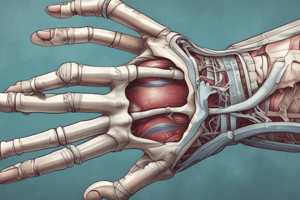Podcast
Questions and Answers
What is the typical cause of a Colles' fracture?
What is the typical cause of a Colles' fracture?
- Twisting injury of the wrist
- Direct impact on the wrist
- Falling onto a flexed wrist
- Falling onto an extended hand (correct)
What type of imaging is often used to detect a snuff box fracture?
What type of imaging is often used to detect a snuff box fracture?
- MRI (correct)
- Ultrasound
- CT scan
- Plain x-rays
Which fracture results in dorsal and radial displacement of the radius?
Which fracture results in dorsal and radial displacement of the radius?
- Colles' fracture (correct)
- Hairline fracture
- Reverse Colles' fracture
- Snuff box fracture
In elderly patients, which mechanism commonly leads to a Colles' fracture?
In elderly patients, which mechanism commonly leads to a Colles' fracture?
What is a common clinical finding associated with a Reverse Colles' fracture?
What is a common clinical finding associated with a Reverse Colles' fracture?
Which treatment is often recommended for snuff box fractures?
Which treatment is often recommended for snuff box fractures?
What is the main reason for follow-up appointments after a fracture?
What is the main reason for follow-up appointments after a fracture?
What indicates a likely need for surgery in a Colles' fracture?
What indicates a likely need for surgery in a Colles' fracture?
Flashcards are hidden until you start studying
Study Notes
Classic Fractures
Colles' Fracture
- A wrist fracture commonly resulting from a fall on an outstretched hand.
- Typically affects elderly patients due to the mechanism of injury involving extended wrists.
- Symptoms include significant swelling and deformity in the distal wrist area.
- Diagnosis is confirmed through plain x-rays, revealing fractures in the distal radius and ulna.
- Treatment may involve surgery; however, splinting and immobilization for about four weeks are often sufficient.
Reverse Colles' Fracture
- Occurs from a fall on a flexed wrist, differing from Colles' fracture.
- Typically results from direct impact on the wrist area while in a flexed position.
- Management mirrors that of Colles' fracture, often requiring splinting or surgery.
Snuff Box Fracture
- Involves a fracture of the scaphoid bone caused by a fall on an outstretched hand with wrist dorsiflexion.
- Pain and tenderness are localized to the anatomical snuff box located on the radial side of the wrist.
- Standard plain x-rays may not detect the fracture; MRI provides a more accurate diagnosis.
- Treatment generally includes thumb splinting, with surgery reserved for severe cases.
General Considerations
- Follow-up appointments are crucial for monitoring the healing process and ensuring proper alignment of fractured bones.
- Repeat x-rays may be used to assess recovery and detect any complications.
Studying That Suits You
Use AI to generate personalized quizzes and flashcards to suit your learning preferences.



